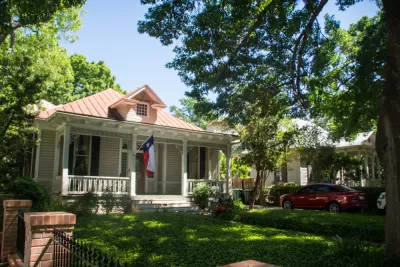The city wants to incentivize the construction of backyard dwelling units, but some councilmembers want to proceed cautiously to ensure the policy benefits local homeowners.

San Antonio officials continue their debate over loosening regulations to encourage more homeowners to build accessory dwelling units (ADUs), locally known as casitas. As Matt Houston reports for KENS, the city’s mayor is touting the backyard homes as one solution to the housing shortage and a way for homeowners to earn additional income.
“Next week, council members will debate ordinance amendments which would allow for larger suites, higher occupancy, and remove some design requirements.” The same proposal would let homeowners install separate electricity meters on casitas.
Critics of the proposal expressed concern that the new regulations would benefit investors more than local residents, a worry that isn’t entirely unfounded. “Investors bought nearly half of all the homes sold in Bexar County in 2021, up from 11 percent in 2020, according to a National Association of Realtors report.” City councilmembers who oppose the proposal say they support incentivizing casitas, but want to see a more detailed enforcement plan that would include owner-occupancy requirements to prevent out-of-town investors from buying up properties, raising rents, and creating short-term rental ‘party houses.’ “Other council members have lobbied for waving [sic] some fees to incentivize construction instead of relaxing certain construction rules.”
FULL STORY: San Antonio leaders want more casitas, but the tiny homes have sparked a big debate

Planetizen Federal Action Tracker
A weekly monitor of how Trump’s orders and actions are impacting planners and planning in America.

Maui's Vacation Rental Debate Turns Ugly
Verbal attacks, misinformation campaigns and fistfights plague a high-stakes debate to convert thousands of vacation rentals into long-term housing.

San Francisco Suspends Traffic Calming Amidst Record Deaths
Citing “a challenging fiscal landscape,” the city will cease the program on the heels of 42 traffic deaths, including 24 pedestrians.

Amtrak Rolls Out New Orleans to Alabama “Mardi Gras” Train
The new service will operate morning and evening departures between Mobile and New Orleans.

The Subversive Car-Free Guide to Trump's Great American Road Trip
Car-free ways to access Chicagoland’s best tourist attractions.

San Antonio and Austin are Fusing Into one Massive Megaregion
The region spanning the two central Texas cities is growing fast, posing challenges for local infrastructure and water supplies.
Urban Design for Planners 1: Software Tools
This six-course series explores essential urban design concepts using open source software and equips planners with the tools they need to participate fully in the urban design process.
Planning for Universal Design
Learn the tools for implementing Universal Design in planning regulations.
Heyer Gruel & Associates PA
JM Goldson LLC
Custer County Colorado
City of Camden Redevelopment Agency
City of Astoria
Transportation Research & Education Center (TREC) at Portland State University
Jefferson Parish Government
Camden Redevelopment Agency
City of Claremont





























